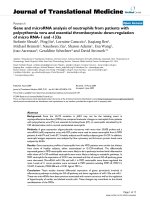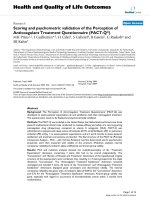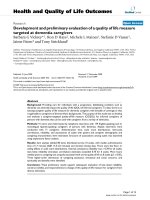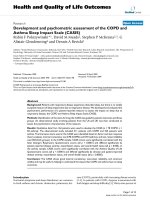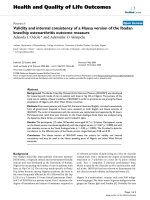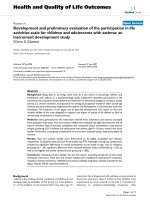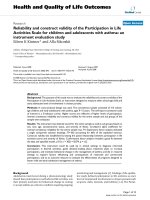báo cáo hóa học:" Passage and concentration-dependent effects of Indomethacin on tendon derived cells" pot
Bạn đang xem bản rút gọn của tài liệu. Xem và tải ngay bản đầy đủ của tài liệu tại đây (448.41 KB, 7 trang )
BioMed Central
Page 1 of 7
(page number not for citation purposes)
Journal of Orthopaedic Surgery and
Research
Open Access
Research article
Passage and concentration-dependent effects of Indomethacin on
tendon derived cells
Emad Mallick*, Nanette Scutt, Andy Scutt and Christer Rolf
Address: Sheffield Centre Of Sports Medicine, School Of Medicine & Biomedical Sciences, Beech Hill Road, Sheffield, S10 2RS, UK
Email: Emad Mallick* - ; Nanette Scutt - ; Andy Scutt - ;
Christer Rolf -
* Corresponding author
Abstract
Background: Non-steroidal anti-inflammatory drugs (NSAID) are commonly used in the
treatment of tendinopathies such as tendonitis and tendinosis. Despite this, little is known of their
direct actions on tendon-derived cells. As NSAIDs have been shown to delay healing in a number
of mesenchymal tissues we have investigated the direct effects of indomethacin on the proliferation
of tendon-derived cells.
Results and Discussion: The results obtained were dependent on both the type of cells used and
the method of measurement. When measured using the Alamar blue assay, a common method for
the measurement of cell proliferation and viability, no effect of indomethacin was seen regardless
of cell source. It is likely that this lack of effect was due to a paucity of mitochondrial enzymes in
tendon cells.
However, when cell number was assessed using the methylene blue assay, which is a simple nuclear
staining technique, an Indomethacin-induced inhibition of proliferation was seen in primary cells but
not in secondary subcultures.
Conclusion: These results suggest that firstly, care must be taken when deciding on methodology
used to investigate tendon-derived cells as these cells have a quite different metabolism to other
mesenchymal derive cells. Secondly, Indomethacin can inhibit the proliferation of primary tendon
derived cells and that secondary subculture selects for a population of cells that is unresponsive to
this drug.
Introduction
Non-steroidal inflammatory drugs (NSAIDs) are com-
monly used for the treatment of a number of muscu-
loskeletal sports injuries including the inflammation of
tendons and ligaments. A number of studies have how-
ever, suggested that NSAIDs may delay soft tissue healing
although the exact mechanism of action for this is
unknown [1-4]. Some in vitro investigations on the effects
of NSAIDs on tenocytes have been performed [5-9]. How-
ever, they have used limited dose-ranges of NSAIDs and
subcultures of tenocytes. We have previously argued that
sub-culturing tenocytes selects for rapidly proliferating
population of cells and is not necessarily representative of
the situation found in vivo where the majority of cells are
non-proliferative [10,11]. In contrast, primary cultures of
tenocytes contain all of the cells originally present in the
Published: 2 April 2009
Journal of Orthopaedic Surgery and Research 2009, 4:9 doi:10.1186/1749-799X-4-9
Received: 11 June 2008
Accepted: 2 April 2009
This article is available from: />© 2009 Mallick et al; licensee BioMed Central Ltd.
This is an Open Access article distributed under the terms of the Creative Commons Attribution License ( />),
which permits unrestricted use, distribution, and reproduction in any medium, provided the original work is properly cited.
Journal of Orthopaedic Surgery and Research 2009, 4:9 />Page 2 of 7
(page number not for citation purposes)
tendon, both differentiated and undifferentiated, and
would therefore seem likely to be a more realistic model
of tendon metabolism. We have therefore investigated the
effects of NSAIDs on both primary tenocytes and second-
ary and tertiary subcultures of the cells.
Methods
Isolation and culture of tendon derived cells: Tendon
derived cells (TDC) were obtained from the tail tendons
of 200 g male Wistar rats. Rat-tail tendons were chosen
because they can be obtained in sufficient quantities to
allow the extensive use of primary cells. Although they are
not completely relevant to human pathologies they show
similar age-related changes in their biomechanical prop-
erties to other tendons and in this laboratory rat tail TDC
behave similarly to cells derived from other tendons;
human and rat. The rats were maintained according to UK
home office regulations and killed by a schedule 1
method. The tendons were dissected free from the tails
and the TDC freed from the tendons by digesting for 18 h
at 37°C in 1 mg/ml crude collagenase in culture medium.
After digestion the cells were washed, resuspended and
viable cells determined.
The cells were then used immediately in primary high-
density cultures or plated out for secondary cultures.
Primary or secondary cells were plated out in 24 well
plates at a density of 10,000 cells per well in DMEM con-
taining 10% FCS, penicillin/streptomycin and glutamine.
The cells were treated with indomethacin (0.1 nm – 100
uM) for 6 days. The cultures were then stopped and cell
number determined by either Alamar blue assay, methyl-
ene blue assay or by direct counting using a Guava PCS.
Alamar blue assay
At the end of the culture period 50 μL of Alamar blue was
added to the cultures, which were then incubated at 37°C
for further four hours. Cell number was then determined
by analysing the supernatants spectrophotometrically at
570 and 600 nm.
Methylene blue assay
The cells were fixed with cold ethanol and then washed
with borate buffer (pH 8.8, 20 mM). Cells were then
stained with methylene blue (1 mg/ml in borate buffer)
for 30 minutes after which they were washed three times
with borate buffer. The dye was then eluted with 1% HCl
in ethanol and cell number determined by measuring the
absorbance at 650 nm.
Guava PCS
The cells were diluted 1 in 10 in Guava Viacount reagent
(containing 7-amino-actinomycin D) and cell number
and viability determined using a guava personal cytome-
try system according to the manufacturer's instructions.
Data handling and statistical analyses: Data are presented
as group mean ± standard deviation. At least 3 replicates
of each experiment were performed, and the results pre-
sented in the figures are representative of these. For each
variable, effects across treatment groups were compared
with one-way analysis of variance (ANOVA). If the overall
difference was significant, multiple comparisons were per-
formed between groups using Tukey's test. Differences are
considered significant at a probability <0.05 on a two-
tailed test.
Results
Initial experiments studying the effects of indomethacin
on tendon derived cell proliferation were carried out
using the commonly used Alamar blue assay. However,
although on visual examination an effect was evident, no
effect was seen after analysis of the cell supernatants (Fig-
ure 1 & Figure 2).
We therefore adopted the methylene blue assay to deter-
mine tendon-derived cell numbers. Although this assay
has the disadvantage of detecting both live and dead cells
it is thoroughly reliable and accurate. Using this assay, it
was found that treating primary cells with indomethacin
lead to a dose related inhibition of cell proliferation.
However, rather unexpectedly the relationship was nega-
tive with the greatest inhibition being seen at 10 nM and
essentially no effect at 100 μM (Figure 3). In secondary
subcultures of tendon-derived cells, the cells became rela-
tively refractive to treatment with indomethacin showing
This graph shows the relationship between increasing Indomethacin concentration and cell number of primary ten-don derived cells as measured by Alamar BlueFigure 1
This graph shows the relationship between increas-
ing Indomethacin concentration and cell number of
primary tendon derived cells as measured by Alamar
Blue.
Journal of Orthopaedic Surgery and Research 2009, 4:9 />Page 3 of 7
(page number not for citation purposes)
no significant effect at any concentration (Figure 4) and
then by the third subculture a biphasic stimulation of pro-
liferation were seen with a maximum at 1–10 μM (data
not shown).
Because of the somewhat unexpected inhibition of prolif-
eration with low concentrations of Indomethacin, this
work was repeated using direct counts of cell number and
viability (as measured by 7-amino-actinomycin D
uptake). Although the concentration relationship was not
as linear as with the methylene blue assay, this too
showed a significant decrease in cell number at lower con-
centrations of indomethacin whereas treatment with high
concentrations had essentially no effect (Figure 5). Also
the results with secondary sub culture of tenocytes were
similar to methylene blue with no effect of indomethacin
on proliferation. We did not repeat this with tertiary sub-
culture of tenocytes.
This graph shows the relationship between increasing Indomethacin concentration and cell number of secondary tendon derived cells as measured by Alamar BlueFigure 2
This graph shows the relationship between increas-
ing Indomethacin concentration and cell number of
secondary tendon derived cells as measured by
Alamar Blue.
This graph shows the relationship between increasing Indomethacin concentration and cell number of primary ten-don derived cells as measured by Methylene BlueFigure 3
This graph shows the relationship between increas-
ing Indomethacin concentration and cell number of
primary tendon derived cells as measured by Methyl-
ene Blue.
This graph shows the relationship between increasing Indomethacin concentration and cell number of Secondary tendon derived cells as measured by Methylene BlueFigure 4
This graph shows the relationship between increas-
ing Indomethacin concentration and cell number of
Secondary tendon derived cells as measured by
Methylene Blue.
This graph shows the relationship between increasing Indomethacin concentration and cell number of primary ten-don derived cells as measured by direct cell counting meth-odsFigure 5
This graph shows the relationship between increas-
ing Indomethacin concentration and cell number of
primary tendon derived cells as measured by direct
cell counting methods.
Journal of Orthopaedic Surgery and Research 2009, 4:9 />Page 4 of 7
(page number not for citation purposes)
The lack of response when measuring the tenocytes cell
number using Alamar Blue was somewhat unexpected as
this is a well established method of determining cell
number and is used with a wide variety of cell types. An
experiment relating cell number and absorption revealed
this to be a cell dependent problem as Methylene blue
staining gave rise to a strong cell-dependent increase in
staining whereas the response using Alamar blue was
essentially flat with very little response (Figure 6). In com-
parison, mesenchymal stem cells produce very similar
curves regardless of whether they are stained with Methyl-
ene blue or Alamar blue (data not shown). To try and
determine the cause of this we stained the cells with 3-
(4,5-Dimethylthiazol-2-yl)-2,5-diphenyltetrazolium bro-
mide (commonly known as MTT) which is metabolized
from yellow MTT to an insoluble purple formazan by a
similar mechanism to Alamar blue. It was found that
whereas Methylene blue stained all of the cells evenly
throughout the cultures, it was evident that there were 2
populations of cells in the tenocyte cultures, one staining
strongly with MTT and the other barely staining at all (Fig-
ure 7).
Discussion
Tendon injuries produce considerable morbidity, and the
disability that they cause may last for several months
despite what is considered appropriate management [12].
The basic cell biology of tendons is still not fully under-
stood, and the management of tendon injury poses a con-
siderable challenge for clinicians [12]. Even though
histological studies have shown absence of acute inflam-
matory cells in chronic tendonitis, NSAIDs are used com-
monly for managing tendon injuries [13-16]. Clinical
studies indicate that they decrease the pain, tenderness
and stiffness associated with acute soft tissue injury 3(4).
The effect of NSAIDs on tenocytes however, remains
debatable. Studies with NSAIDs have shown both benefi-
cial [7,17] and harmful effects on tenocytes [6,8]. As the
tenocyte is the major cell type in tendons and is responsi-
ble for the production and maintenance of extra cellular
matrix, we investigated the effect of Indomethacin, com-
monly used NSAIDs for tendon injuries on tenocyte pro-
liferation. Of particular interest to our study was the effect
of primary and sub culture of tenocytes and different cell
counting methods for tenocytes.
Tenocyte culture provides a uniform, controlled environ-
ment in which to study the in vitro effects of Indometh-
acin, with limitation of other uncontrolled variables and
avoidance of the confounding influences that are present
in animal models [18]. The results of our in vitro experi-
ments showed that Indomethacin had a dose related effect
on tenocyte proliferation. Indomethacin reduced the
number of human tenocyte cells at a dose between 0.1 nM
to 100 nM. However at higher doses it did not inhibit ten-
ocyte proliferation. This is in contrast to some studies
showing inhibition of tenocytes with therapeutic doses of
Indomethacin and hence producing a negative effect on
healing tendons [6,8]. Other studies have shown benefi-
cial effect on tenocyte healing by increasing the tensile
strength to failure [5,7,17]. This is due to increased matu-
ration of collagen fibrils during healing. However it is still
debatable whether this beneficial effect is due to prolifer-
ation of tenocytes or increased production of collagen and
maturation. Our study indicating that Indomethacin in
therapeutic doses did not inhibit tenocyte proliferation
has clinical relevance. This would be beneficial in tendon
healing and repair as tenocyte is the major cell type in ten-
dons and is responsible for the production and mainte-
nance of extracellular matrix.
The negative dose response effect of Indomethacin on ten-
don derived cell proliferation remains a conundrum and
we have no explanation to this. It should however be
noted that serum levels of Indomethacin generally reach a
peak of 1–10 μg/ml after administration and due to the
poor blood supply in tendons, it is likely that tenocytes
are exposed to concentrations even lower than this. These
concentrations are well within the range at which the
above effects were seen in vitro but did not go any way
towards explaining the lack of effect at higher concentra-
tions.
Dissimilar culture conditions as in vivo or in vitro, differ-
ing species and even changes in cell culture conditions of
the same species have shown different tenocyte behaviour
[5-7,17-20]. It can thus be stated that interaction between
Comparison of absorbances of Alamar blue and methylene blue obtained after culture of rat tail tendon derived cells at varying concentrations for 2 and 7 daysFigure 6
Comparison of absorbances of Alamar blue and
methylene blue obtained after culture of rat tail ten-
don derived cells at varying concentrations for 2 and
7 days. Data points are mean of 3 wells. Results were signifi-
cant between cell numbers seeded for both dyes at both
time points using ANOVA.
Journal of Orthopaedic Surgery and Research 2009, 4:9 />Page 5 of 7
(page number not for citation purposes)
tenocytes and NSAIDS is influenced by different factors,
leading to opposing results. It has been previously argued
that sub culture of mesenchymal cells do not reciprocate
in vivo results [11]. However this effect has not been stud-
ied or documented before, with tenocytes. We considered
this as an important area of investigation and looked at
role of culture conditions on effect of Indomethacin on
tenocytes. We noted that sub culture of cells did not show
similar results as primary tenocytes. The dose dependent
effect of Indomethacin was only seen on primary teno-
cytes and sub culture of cells did not show this effect. Pre-
vious studies have shown Indomethacin to cause both
inhibition and proliferation of tenocytes in in vitro stud-
ies [6,10,14,17]. However these studies do not clearly
indicate if only primary or subcultures of cells were used.
Also it has not been mentioned previously if such effect
was seen. We postulate that this effect seen in our study
may be due to the selection of a highly proliferative pop-
ulation of tenocytes that is present in the primary digest
only at low levels which subsequently overgrow the
slower growing cells in later passages. We consider this an
important finding, as studies, which have used sub culture
of cells, need to be reviewed with some caution.
Various cell-counting methods are used to measure teno-
cyte proliferation. Initial experiments studying the effects
of Indomethacin on tendon derived cell proliferation
were carried out using the commonly used Alamar blue
assay. However, although on visual examination an effect
was evident, no effect was seen after analysis of the cell
supernatants. This conundrum was subsequently
explained by the finding that tendons appear to contain 2
subpopulations of cells; one subpopulation with appar-
ently normal metabolic activity and a second subpopula-
tion of cells with low levels of mitochondrial enzymes
and subsequently a low oxidative metabolism. As the
Alamar blue assay is dependent on mitochondrial enzyme
activity for the reduction of the dye resazurin to resorufin,
in cells without these enzymes, no effect was seen. This
was confirmed by the use of MTT which is metabolized by
the same enzymes to produce a purple product and it was
clearly demonstrated that 2 subpopulations of cells exist;
one staining intensely indicating a high metabolic activity
and one stained relatively mildly indicating a low meta-
bolic activity. This is entirely consistent current knowl-
edge regarding the metabolic activity of tenocytes and
tenoblasts. Tenoblasts are known to contain relatively
high numbers of mitochondria and tenocytes very few
suggesting comparatively high and low oxidative metabo-
lism respectively [21]. This would in turn that the
response seen in primary cells is due to the presence of
mature tenocytes in the cultures which would have been
lost on subsequent passage. As tenocytes are thought to be
non-proliferative it is obviously unlikely that this is due to
an inhibition of proliferation. One possibility is a toxic
effect on specific to tenocytes but not tenoblasts however,
we saw no evidence of excessive cell death in these cul-
tures. Another possibility is that the tenocytes play some
Staining of tendon derived cells with A, methylene blue or B, MTTFigure 7
Staining of tendon derived cells with A, methylene blue or B, MTT. Monolayer cultures of rat tail tendon cells were
grown to confluence, then stained with these substances as described in materials and methods. Following staining cultures
were photographed. Staining with methylene blue produces even staining whereas staining with MTT produces patchy results
with some cells staining strongly and others barely staining at all.
A. B.
Journal of Orthopaedic Surgery and Research 2009, 4:9 />Page 6 of 7
(page number not for citation purposes)
form of regulatory role controlling the proliferation of the
proliferative tenoblasts as is thought to be the case for
osteocytes and osteoblasts [22]. This must however
remain speculative until further evidence is available.
One consequence of these data is that investigations using
Alamar blue or MTT to assess tenocytes numbers should
be interpreted with some caution. We therefore adopted
the methylene blue assay to determine tendon-derived
cell numbers. Although this assay has the disadvantage of
detecting both live and dead cells it is thoroughly reliable
and accurate. Using this assay, it was found that treating
primary cells with indomethacin led to a dose related
inhibition of cell proliferation. In secondary subcultures
of tendon-derived cells, the cells became relatively refrac-
tive to treatment with indomethacin showing no signifi-
cant effect at any concentration (Figure 4). Because of the
somewhat unexpected inhibition of proliferation with
low concentrations of Indomethacin, this work was
repeated using direct counts of cell number and viability
(as measured by 7-amino-actinomycin D uptake).
Although the concentration relationship was not as good
as with the methylene blue assay, this too showed a signif-
icant decrease in cell number at lower concentrations of
indomethacin whereas treatment with high concentra-
tions had essentially no effect (Figure 5).
The cause of this rather unexpected dose/effect relation-
ship is at present unclear. Indomethacin is thought to act
principally by the modulation of arachidonic acid metab-
olism via the cyclooxygenase and lipoxygenase pathways
thus blocking the production of prostaglandins and
HETEs/leukotrienes respectively. The relationship is how-
ever not simple as indomethacin has been shown to stim-
ulate [23] and inhibit [24] the production of lipoxygenase
metabolites. This differential effect is likely to be both tis-
sue and concentration dependent and is further compli-
cated by the possibility that blocking one pathway is likely
to shunt metabolites down the other. No drugs are 100%
specific for any one particular mechanism of action and
indomethacin is no exception giving rise to a number of
effects unrelated to cyclooxygenase [25]. Lastly, endocan-
nabinoids are now known to have a number of peripheral
effects on connective tissue [26] and preliminary investi-
gations in this laboratory indicate that this is also the case
in tendons and ligaments. In relation to this, indometh-
acin has been shown to inhibit the enzyme fatty acid
amide hydrolase (FAAH), which metabolizes endocan-
nabinoids [27]; inhibition of FAAH would therefore result
in the build of levels of endocannabinoids. The situation
is therefore highly complex and is unlikely to be
unraveled until further insights into the relative roles of
prostaglandins, leukotrienes and endocannabinoids in
tendons are obtained.
It should be stressed that in this study we have only inves-
tigated the effects of indomethacin on cell proliferation
and therefore no firm conclusions can be made regarding
the effects of indomethacin on other metabolic processes.
There have been few studies on tendon cells monitoring
both proliferation and collagen accumulation, however,
we have found that collagen accumulation in tendon cells
normally parallels cell number and that specific levels of
collagen synthesis remain largely unchanged [28-31]. This
would suggest that indomethacin would probably pro-
duce similar effects on matrix protein synthesis to those
described above, although this obviously requires confir-
mation.
Conclusion
In conclusion, these data show that primary tenocytes
respond to Indomethacin differently compared to second-
ary and tertiary subcultures. This may be due to the selec-
tion of a highly proliferative population of tenocytes that
is present in the primary digest only at low levels which
subsequently overgrows the slower growing cells in later
passages. This would suggest that where possible in vitro
investigations into tenocyte metabolism should preferen-
tially be performed using primary cells and that results
obtained using subcultures should be viewed with some
caution.
Furthermore we have shown that because of their lower
metabolic rate tendon derived cells cannot sufficiently
metabolise Resazurin, the dye used in the Alamar blue
assay. Because of this we would suggest that this essay is
not appropriate studying proliferation in tendon derived
cells and that an alternative, such as the methylene blue
assay, should be used.
Competing interests
No author in any form has received any financial support
or reward for this study. Also there are no non – financial
competing interests.
Authors' contributions
All authors have significantly contributed in the concep-
tion and design, or acquisition of data, or analysis and
interpretation of data and have been involved in drafting
the manuscript or revising it critically for important intel-
lectual content; and have given final approval of the ver-
sion to be published.
References
1. Almekinders LC: Anti-inflammatory treatment of muscular
injuries in sport. An update of recent studies. Sports Med 1999,
28(6):383-8.
2. Almekinders LC: The efficacy of nonsteroidal anti-inflamma-
tory drugs in the treatment of ligament injuries. Sports Med
1990, 9:137-142.
3. Almekinders LC, Temple JD: Etiology, diagnosis, and treatment
of tendonitis: an analysis of the literature. Med Sci Sports Exerc
1998, 30:1183-1190.
Publish with BioMed Central and every
scientist can read your work free of charge
"BioMed Central will be the most significant development for
disseminating the results of biomedical research in our lifetime."
Sir Paul Nurse, Cancer Research UK
Your research papers will be:
available free of charge to the entire biomedical community
peer reviewed and published immediately upon acceptance
cited in PubMed and archived on PubMed Central
yours — you keep the copyright
Submit your manuscript here:
/>BioMedcentral
Journal of Orthopaedic Surgery and Research 2009, 4:9 />Page 7 of 7
(page number not for citation purposes)
4. Weiler JM: Medical modifiers of sports injury: the use of non-
steroidal anti-inflammatory drugs (NSAIDs) in sports soft
tissue injury. Clin Sports Med 1992, 11:625-644.
5. Carlstedt CA, Madsen K, Wredmark T: The influence ofind-
omethacin on collagen synthesis during tendon healing in
therabbit. Prostaglandins 1986, 32(3):353-8.
6. Cohen D, Kawamura S, Ehteshami JR: Indomethacin and-
celecoxib impair rotator cuff tendon-to-bone healing. Am
JSports Med 2006, 34(3):362-9. 19
7. Forslund C, Bylander B, Aspenberg P: Indomethacin and
celecoxib improve tendon healing in rats. Acta Orthop Scand
2003, 74(4):465-9.
8. Riley GP, Cox M, Harrall RL, Clements S, Hazleman BL: Inhibition
of tendon cell proliferation and matrix glycosaminoglycan
synthesis by nonsteroidal anti-inflammatory drugs in vitro. J
Hand Surg [Br] 2001, 26(3):224-8.
9. Thomas J, Taylor D, Crowell R, Assor D: The effect ofindometh-
acin on Achilles tendon healing in rabbits. Clin Orthop Relat Res
1991:308-11.
10. Mallick E, Rolf C, Scutt A: Effect of Indomethacin on rat teno-
cyte viability in vitro: role of culture condition. Proceedings of
British Orthopaedic Research Society meeting 2004.
11. Scutt A, Bertram P: The role of glucocorticoids andprostaglan-
dins E2 in the recruitment of bone marrow mesenchymal
osteoblastic lineage. Calcif Tiss Int 1996, 59(3):154-62.
12. Sharma Pankaj, Maffulli Nicola: Tendon Injury and Tendinopathy:
Healing and Repair. J Bone Joint Surg Am 2005, 87:187-202.
13. Khan KM, Maffulli N: Tendinopathy: an Achilles' heel for ath-
letes and clinicians. Clin J Sport Med 1998, 8:151-154.
14. Martens M, Wouters P, Burssens A: Patellar tendonitis: pathol-
ogy and results of treatment. Acta Orthop Scand 1982,
53:445-450.
15. Merkel KH, Hess H, Kunz M: Insertion tendinopathy in athletes.
A light microscopic, histochemical and electron microscopic
examination. Pathol Res Pract 1982, 173:303-309.
16. Potter HG, Hannafin JA, Morwessel RM, DiCarlo EF, O'Brien SJ,
Altchek DW: Lateral epicondylitis: Correlation of MR imag-
ing, surgical, and histopathologic findings. Radiology 1995,
196:43-46.
17. Carlstedt CA, Madsen K, Wredmark T: The influence of
indomethacin on biomechanical and biochemical properties
of the plantaris longus tendon in the rabbit. Arch Orthop
Trauma Surg 1987, 106(3):157-60.
18. Wong MW, Tang YY, Fu BS, Chan CK, Lee SK, Chan BP: Effect of
dexamethasone on cultured human tenocytes and its revers-
ibility by Platelet-Derived Growth Factor. J Bone Joint Surg Am
2003, 85:1914-1920.
19. Almekinders L, Deol G: The effects of aging, anti inflammatory
drugs, and ultrasound on the In Vitro response of tendon tis-
sue.biomechanical and biochemical properties of the
plantaris longus tendon in the rabbit. Arch Orthop Trauma Surg
1987, 106(3):157-60.
20. Wang ED: Tendon repair. Journal of Hand Therapy 1998, 11:105-10.
21. Jozsa L, Kannus P: Human Tendons: Anatomy, Pyhsioloogy and
Pathology. Human Kinetics Europe Ltd; 1997.
22. Civitelli R: Cell-cell communication in the osteoblast/osteo-
cyte lineage. Arch Biochem Biophys 2008, 473(2):188-92.
23. Docherty JC, Wilson TW: Indomethacin increases the forma-
tion of lipoxygenase products in calcium ionophore stimu-
lated human neutrophils. Biochem Biophys Res Commun 1987,
148(2):534-8.
24. Uotila P, Männistö J, Simberg N, Hartiala K: Indomethacin inhibits
arachidonic acid metabolism via lipoxygenase and cyclo-oxy-
genase in hamster isolated lungs. Prostaglandins Med 1981,
7(6):591-9.
25. Tegeder I, Pfeilschifter J, Geisslinger G: Cyclooxygenase-inde-
pendent actions of cyclooxygenase inhibitors. FASEB J 2001,
15(12):2057-72.
26. Scutt A, Williamson EM: Cannabinoids stimulate fibroblastic
colony formation by bone marrow cells indirectly via CB2
receptors. Calcif Tissue Int
2007, 80(1):50-9.
27. Fowler CJ, Holt S, Nilsson O, Jonsson KO, Tiger G, Jacobsson SO:
The endocannabinoid signaling system: pharmacological and
therapeutic aspects. Pharmacol Biochem Behav 2005,
81(2):248-62.
28. Scutt N, Rolf C, Scutt A: Tissue specific characteristics of cells
isolated from human and rat tendons and ligaments. J Orthop
Surg Res 2008, 3:32.
29. Scutt N, Rolf CG, Scutt A: Glucocorticoids inhibit tenocyte pro-
liferation and Tendon progenitor cell recruitment. J Orthop
Res 2006, 24(2):173-82.
30. Chen CH, Tsai JL, Wang YH, Lee CL, Chen JK, Huang MH: Low-level
laser irradiation promotes cell proliferation andmRNA
expression of type I collagen and decorin in porcine achilles-
tendon fibroblasts In Vitro. J Orthop Res 2008 in press.
31. Torricelli P, Fini M, Giavaresi G, Carpi A, Nicolini A, Giardino R:
Effects of systemic glucocorticoid administration on teno-
cytes. Biomed Pharmacother 2006, 60(8):380-5.
